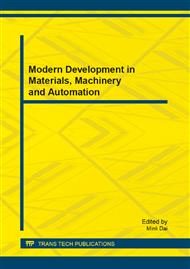[1]
S. Bermejo, Desarrollo de robots basados en el comportamiento. ISBN 84-8301-712-1., UPC, (2003).
Google Scholar
[2]
lanacion. com, Da vinci, el primer robot cirujano, ya opera en la argentina, (Julio de 2008).
Google Scholar
[3]
M. Salazar, Cim-manufactura integrada por computadora, (Agosto de 2009).
Google Scholar
[4]
BBC, Manos robóticas que sienten lo que tocan, (Junio de 2012).
Google Scholar
[5]
Robotnik, Manos robóticas.
Google Scholar
[6]
D. Whitney, Force feedback control of manipulator fine motions, Proceedings Joint Automatic Control Conference, (1976), San Francisco.
Google Scholar
[7]
M. Mason, Compliance and force control for computer controlled manipulators, tech. rep. Laboratorio de InteligenciaArtificila (IA) del MIT, (Mayo de 1978).
Google Scholar
[8]
M. Raibert, Hybrid position/force control of manipulators, ASME Journal of Dynamic Systems, Measurement, and Control, (Junio de 1981).
Google Scholar
[9]
N. Hogan, Stable execution of contact tasks using impedance control, Proceedings of IEEEConference on Robotics and Automation., (1987). Raleigh, NC.
DOI: 10.1109/robot.1987.1087854
Google Scholar
[10]
J. K. Salisbury, Active stiffness control of manipulator in cartesian coordinates, 19th IEEEConference on Decision and Control, (diciembre de 1980).
DOI: 10.1109/cdc.1980.272026
Google Scholar
[11]
S. Chiaverini, Controllo in forza di Manipolatori (in Italian). PhD thesis, Tesi di Dottorato diRicerca, UniversitadegliStudi di Napoli Federico II, (1990).
Google Scholar
[12]
W. A. Wolovich, Automatic control systems. basic analysis and desing, Saudewrs CollegePublishing, (1995).
Google Scholar
[13]
C. J. V. Bisso, Controle de posição de robôs manipuladores rígidos e comtransmisõesflexiveis, dissertação de mestrado, tech. rep., Univesidade Federal de Santa Catarina, Brasil, (1999).
Google Scholar
[14]
T. P. V. Fernando, Independient joint control using two degree of fredom control structures, (Italy), p.552–556, Proccding of IEEE International Conference on Control Applications, (1998).
Google Scholar
[15]
A. O. Baturone, Robótica. Manipuladores y robots móviles. (2001).
Google Scholar
[16]
I. A. O. Caparroso, Análisis cinemático de un robot industrial tipo scara, Revista de la facultad de ingeniería, p.17–27, (Julio de 1999).
Google Scholar
[17]
F. R. Cortés, Robótica. Control de Robots Manipuladores. Alfaomega, (Marzo de 2011).
Google Scholar
[18]
J. Craig, Robótica. Prentice Hall, (2006).
Google Scholar
[19]
D. J. M. . W. King, Dinamica II: Mecánica para ingeniería y sus aplicaciones. (2004).
Google Scholar
[20]
B. S. Lorenzo Sciavicco, Modeling and control of robot manipulators. Series in Electrical andComputer Engineering. Lorenzo Sciavicco, Bruno Siciliano., (1996).
Google Scholar
[21]
E. Prisma. com, Dinámica del cuerpo rígido-fundamentos, (Diciembre de 2009).
Google Scholar
[22]
O. Khatib, A unified approach to motion and force control of robot manipulators: the operational space formulation, IEEE. of Robot. Autom., p.43–53, (1987).
DOI: 10.1109/jra.1987.1087068
Google Scholar


